Visit the art blog at thematicconversion.tumblr.com and the relog blog at evtrained.tumblr.com.
92 posts
Historyclasses - History Classes - Tumblr Blog
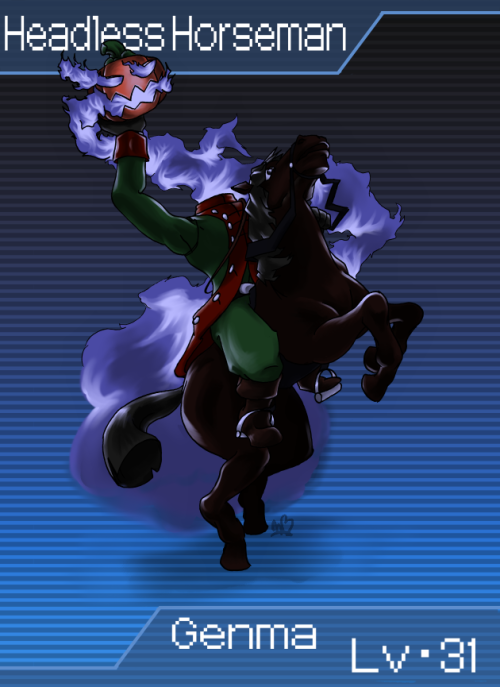
01 of 05 - Modern Compendium: Deity Family, Part 4 - Genma Headless Horseman
Holy crap that took a lot longer than I expected. I did not have a full appreciation for the complexity of this design. @_@
But yes! The Headless Horseman! Introduced to the United States in the early 19th century by Washington Irving’s The Legend of Sleepy Hollow, the Horseman is based on a long-standing tall tale that has surprisingly deep roots in history. Irving’s version of the Headless Horseman is said to be the ghost of a Hessian mercenary who had his head blown off by cannon fire in the Revolutionary War, but there are tales of Horsemen as far back as the Middle Ages. In fact, there’s a good chance that early tales of headless riders were inspired by the long-standing Irish fairy story of the Dullahan, an animated suit of armor that rode a black steed through the countryside, and who could kill simply by speaking the victim’s name.
The Legend of Sleepy Hollow has always been a popular American myth, especially around Halloween, and its impact on pop culture is pretty easy to see. The Horseman appears on Halloween-themed merchandise every year, there’s a popular Disney short about him – hell, there are even high school football teams that have the Horseman as a mascot, and if that doesn’t say mainstream acceptance, I don’t know what does. The Headless Horseman is unique in one interesting way, though; it is one of the few Halloween monsters that have been able to resist the slide into kitsch. You might see cutesy ghosts and witches at Halloween, for example, but a cute Horseman is pretty rare.
As a uniquely American monster, the Headless Horseman fits neatly into the Genma family. He is right at the bottom, but the Horseman is a powerful demon for its level, and would probably qualify as one of the early special Fusions.
For more info on this and every other demon in the Modern Compendium, have a look at our extensive Data File, right over (here).

05 of 05 - Modern Compendium: Kishin Family, Part 5 - Kishin Wanjiku
There really is nothing more revealing about a national identity than the figures and ideals they use to represent them. For example, when the United States of the 1950s saw Uncle Sam, they knew they were looking at a paternalistic figure, a figure of authority with just a hint of familial affection. So when the people of Kenya chose to refer to the common man in the street as Wanjiku, it represents an interesting insight into their national identity.
The name Wanjiku comes from the origin myths of the Agikuyu tribe, one of the largest ethnic groups in Kenya. They say that the first man and woman, known as Gikuyu and Mumbi, were created by God and had nine children. Wanjiku was one of these children, and later went on to found the Agikuyu tribe.
Interestingly, the practice of referring to the general public of Kenya as Wanjiku is a relatively recent thing. It seems that during a crisis, former president Daniel arap Moi dismissed calls for a new constitution by saying, “Do you think Wanjiku understands what is a constitution?” Which, frankly, makes the whole thing downright hysterical in my eyes. You have to have a wonderful little contrarian streak to take a name hurled at you as an insult and turn it into the personification of your country.
Though Wanjiku is quite popular in her home country, knowledge of this figure is in no way wide-spread. Because of this, she hovers around the middle of the Kishin family. She does have a nicely broad selection of skills to learn, though, so it’s not a total loss.
For more info on this and every other demon in the Modern Compendium, have a look at our ever expanding Data File, right over (here).
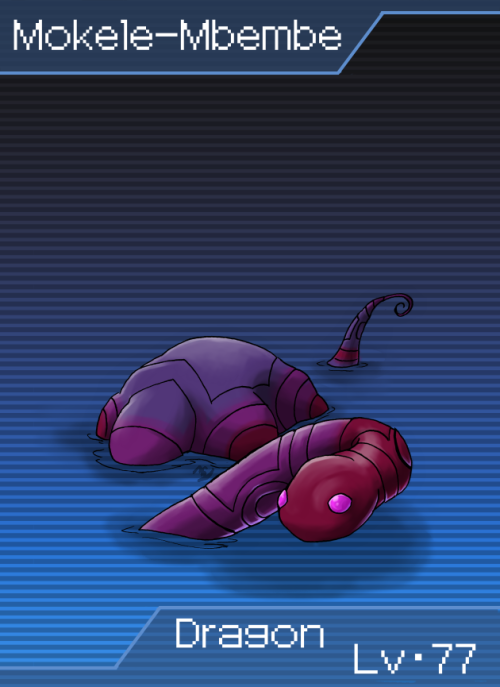
04 of 05 - Modern Compendium: Kishin Family, Part 5 - Dragon Mokele-Mbembe
One of the most famous Cryptids, Mokele-Mbembe is actually an excellent example of the way cultural mythologies color the way different societies interact. Physically, it straddles the divide between lost beast and sea serpent, while the mythology associated with it flits between pseudoscience and spiritualism.
See, in the Congo River basin region of Africa, locals have stories of a massive, wrinkled beast that wades in the rivers – the name “Mokele-Mbembe” actually means “the one who stops the flow of rivers.” They describe it as a nature spirit, a territorial beast, and a guardian of the water.
However, to westerners, the Mokele-Mbembe is something else. Explorers who visited the region in the early 20th century heard tales of a wrinkled, long-necked herbivore in the waters and, rather than taking the local’s stories at face value, decided they were describing a sauropod dinosaur. Since then, the Mokele-Mbembe has been taken up by Cryptozoologists as a likely living fossil, a survivor from prehistory when dinosaurs roamed the earth.
There is, of course, little evidence to support this theory, but the effect that the overlay of Cryptid mythology on Mokele-Mbembe has had on the imagination of the west is undeniable. Stories of long-lost dinosaurs in Africa have influenced countless popular movies, from King Kong to Land of the Lost, and helped to establish Africa in the minds of westerners as a place where mystical beasts wandered free.
In Shin Megami Tensei terms, Mokele-Mbembe is a mid-range Dragon. Like most of its family, the critter is largely defensive in nature, but it is also one of the few demons to learn Doping, making it a valuable addition to any player’s Compendium.
For more info on this and every other demon in the Modern Compendium, have a look at our Data File, right over (here).
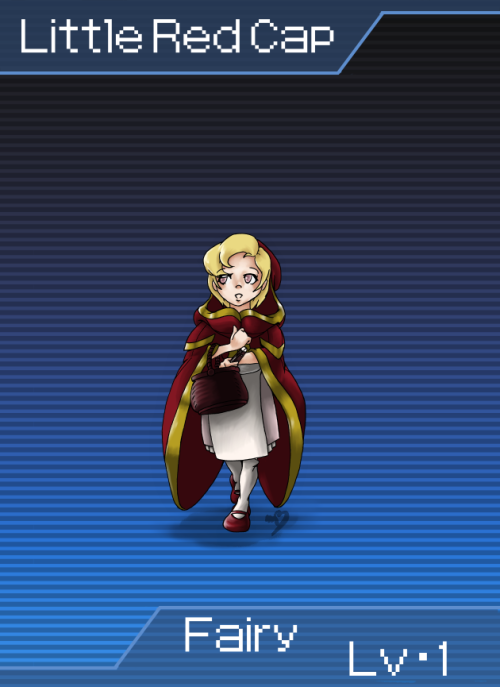
01 of 05 - Modern Compendium - Fairy Little Red Cap
This WAS going to be just a reblog to show I updated Little Red Cap’s artwork, but Tumblr doesn’t let you edit your stuff that way anymore. But that’s okay, I’m not really happy with how the old post reads anyway. So let’s do the whole thing over again! 8D
Anyway, Little Red Cap, better known as Red Riding Hood, is a perennially popular figure from fairy stories. The basic story is of course well known; a young girl is sent off to bring food to her ailing grandmother, but she has to go through the woods to get to grandma’s house. Along the way, a wolf stalks her, learns where she’s going, and gets to the house first, where she eats the girl’s grandmother. Little Red Riding Hood arrives at the house and engages in a battle of wits with the wolf, with the girl suspicious of her grandmother’s new appearance. There are a lot of variations on the ending, but usually the girl and her grandmother escape unscathed.
The popularity and extremely long history of Red Riding Hood’s story means there is a huge number of variations on the story. Sometimes the grandmother is eaten, sometimes she’s just imprisoned. Sometimes Red Riding Hood is saved by a woodcutter, and sometimes she outsmarts the beast. Heck, sometimes the wolf is a werewolf and LRRH actually has no cape on. Some scholars believe the story has origins as far back as the 10th century AD, so there may be as much as a thousand years worth of variation to work with here.
There is one major defining thing about the story that never changes. The underlying message of Little Red Riding Hood’s story is that there is a clear delineation between HERE, which is safe, and the scary, dangerous, wolf-infested THERE, and that wandering into it is not a good idea. I feel like that’s a good way to start a Shin Megami Tensei story - by announcing that you’ve just wandered into a very dangerous place that you should not be.
See, Little Red Cap is the Modern Compendium’s Pixie. She’s the first demon you meet, and she’s more or less your introduction to how demon allies work. She’s also capable of mass destruction should you level her high enough, learning Megidolaon at Lv. 65, which is actually a lower level than most other demons who get the skill. I admit this is equal parts a reference to the high-powered late game Pixie of Nocturne and my own love of cute things that are secretly capable of mass destruction.
For more info on this and every other demon in the Modern Compendium, have a look at our Data File, right over (here).
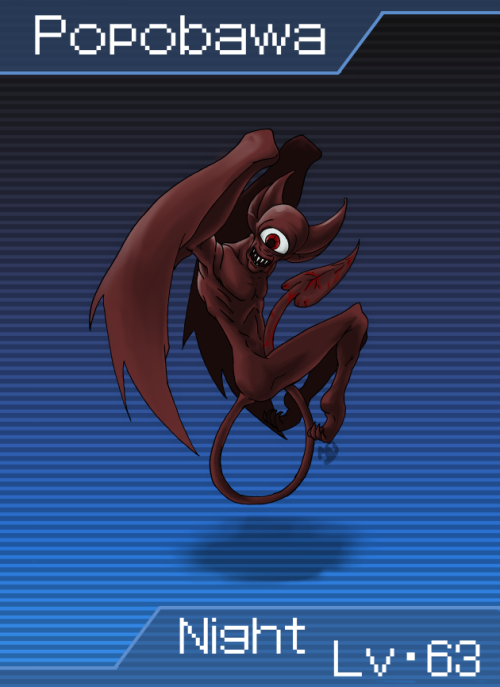
01 of 05 - Modern Compendium: Kishin Family, Part 5 - Night Popobawa
The mythology of Tanzania, an African country on the eastern coast of the continent, is a fascinating mix of ideas from Christianity, Islam, and myriad native folk religions. In modern times, these ideas have combined with politics and western Cryptozoology to create a truly novel demon known as the Popobawa.
The characteristics of the Popobawa are actually fairly similar to the Incubus of ancient Christian belief; a dark spirit, sometimes summoned by a sorcerer, to sexually assault people, usually women, in their sleep. However, the Popobawa is said to be a shapeshifter, only recognizeable by its bat-winged shadow – in fact the name “Popobawa” actually translates to “bat wing.” The creature is also said to be responsible for Poltergeist-like activity in homes and other physical attacks.
Popobawa reports have been responsible for several mass panics in Tanzania’s history, the most recent being in 2007. A couple of odd quirks in the creature’s mythology have helped this along; first, the idea that a Popobawa’s attacks can only be stopped by telling someone about them; and second, the fact that these reports multiply during election season. That’s right, there is a distinct possibility that we are looking at politically motivated fear mongering in the shape of a shadowy cycloptic man-bat. At least it’s more straightforward than color-coded terror charts, I guess.
At any rate, the Popobawa rates pretty high in the Night family, largely thanks to the heights of terror it inspires in populations that believe in it. Mechanically, it actually takes the place of the Succubus as the go-to Charm-based sex demon, though it is of course a bit more physically specialized.
For more info on this and every other demon in the Modern Compendium, have a look at the Data File, right over (here)!
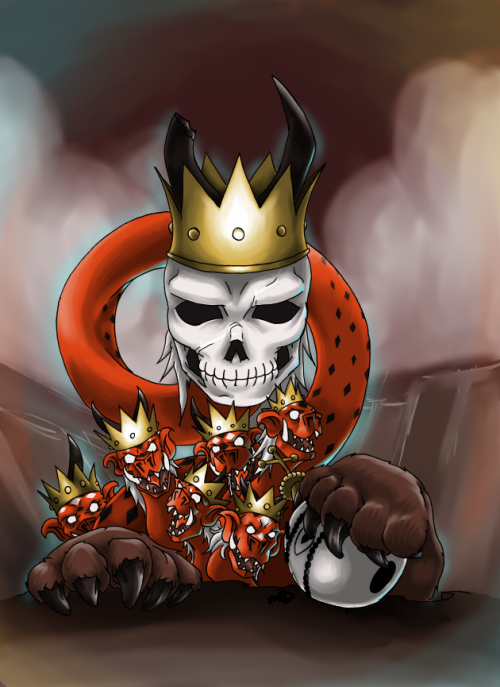
OUR ARRIVAL HAS BEEN ORDAINED
OURS IS THE FIRST SIGN, THE HERALD AND THE BLASPHEMY
THOSE WHO SEEK OUR COMING SHALL SEE US IN EVERY LORD
THEY SHALL SAY, “THIS MAN IS AN OUTSIDER, THIS WOMAN IS THE HARLOT”
THEY SHALL SEEK OUR SACRED NUMBER, AND TWIST TRUTH TO FIND IT WHERE IT IS NOT
YET OUR POWER EXISTS IN ALL PLACES WHERE MEN SEPARATE INTO “WE” AND “THEY”
WE ARE THE CONFLICT, AND THE PREDJUDICE, AND THE FEAR OF THE OTHER
YET ALL SHALL BEND TO THE WILL OF THE BEAST
EVEN YOU, HUMAN
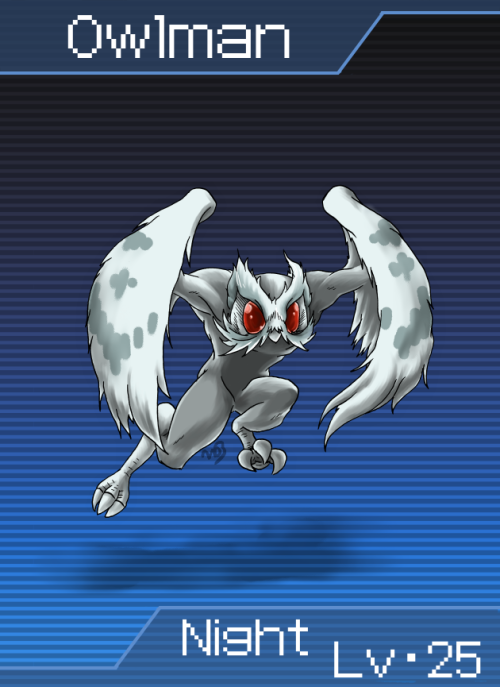
05 of 05 - Modern Compendium: Kishin Family, Part 4 - Night Owlman
First off, a bit of a confession; when I scheduled Owlman for this ALL AMERICAN FIREWORK DEMONFEST, I, uh, thought Owlman had been reported in the United States. I figured hey, we already did Thunderbird, we need an avian to stand in for the Bald Eagle, let’s do Owlman. Imagine my shock when I went back to my research and realized he’s an English critter. Whoops. ^^;
Oh well. Press ahead anyway! Owlman is a Cryptid first sighted in Cornwall, specifically in the village of Mawnan. The first reports painted a picture of a winged man with huge glowing eyes and clawed feet, hovering above the church steeple. Since then, there have been multiple sightings of the beast, all following along similar lines.
Many different solutions to the mystery of the Owlman have been suggested. Some say that the village church lies on a major leyline, and that the Owlman may be an embodiment of the spirit of the land, wreaking vengeance on humankind. Others point out that there are in fact colonies of Eagle Owls nearby, which have a wingspan of something like six feet and whose eyes are enormous and reflect light quite well in the dark. Or, given that the first person to seriously write about the Owlman was a well-known hoaxer named Tony Shiels, it’s entirely possible that the whole thing is just a joke that got out of hand.
At any rate, many people have compared the Owlman to North America’s Mothman, a fact which has always confused me. The Mothman is widely regarded as a sort of latter-day Banshee, bringing warning of disaster along with its menacing fly-bys, but the Owlman has never been seen to do anything but chase folks around and screech a fair bit.
Because of the general shakiness of its base of belief, and because it’s not generally considered actually dangerous or powerful at all, the Owlman sits very low in the Night family. Right at the bottom, as a matter of fact.
For more info on this and every other demon in the Modern Compendium, have a look at our Data File, right over (here).
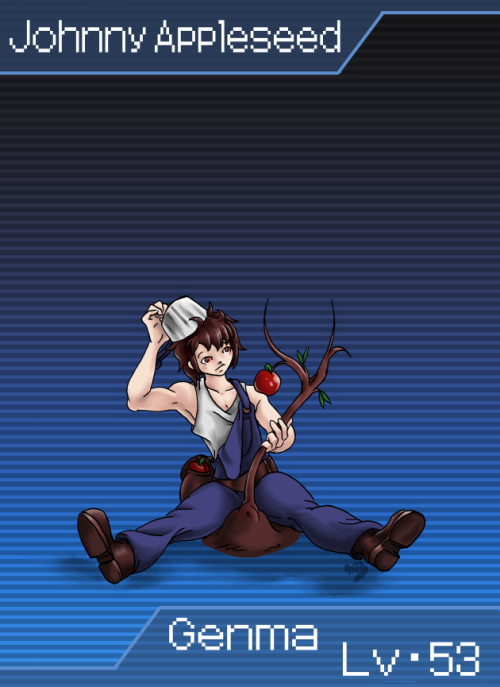
04 of 05 - Modern Compendium: Kishin Family, Part 4 - Genma Johnny Appleseed
I usually try to shy away from including figures in the Compendium that were actual people, but much like Tokisada in SMTIV, Johnny Appleseed sits at such a crossroad of mythology and culture that his omission would be glaring.
Born in the late 18th century as John Chapman, Johnny Appleseed is unique in the company of modern American folklore in that most of the stories told about him are in fact true. He did travel most of the United States of his time, planting apples, and doing missionary work. It seems he was widely respected by the Native Americans, being allowed to move more or less freely through the lands of several different tribes.
The mythological legacy of Johnny Appleseed is heavily tied in with several significant parts of American identity; He is seen as a settler heading west, expanding the US, personifying self-reliance and the concept of Manifest Destiny; His kinship with the land and animals is a big part of stories told about him in the service of conservation and land management; And of course his missionary work is heavily emphasized by those who see America first and foremost as a Christian nation.
As a perennially popular American figure, Johnny Appleseed fits reasonably high in the Genma family. Really, the only thing that keeps him from being even higher is that he’s never really seen as a force to be reckoned with, but rather as someone who would rather avoid conflict.
For more info on this and every other demon in the Modern Compendium, have a look at our extensive and growing Data File, right over (here)!
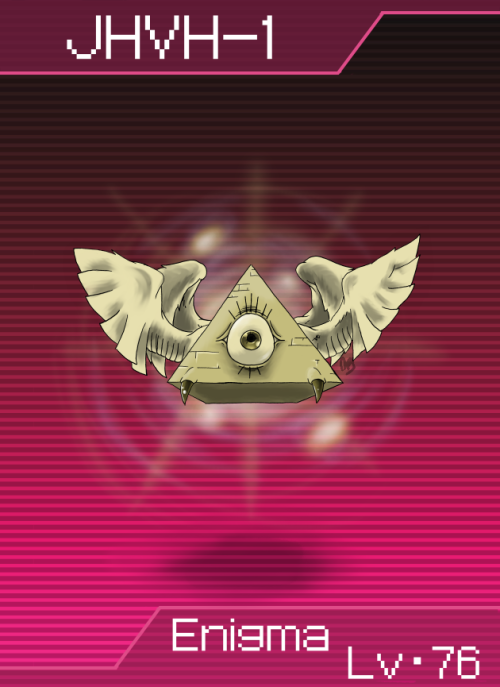
Warning! Fusion error
Warning! Fusion error
Warning! Fusion error
Program was forced to close by a remote observer Source detected 37.2350° N, 115.8111° W Message included: WARNEDYOUWARNEDYOUWARNEDYOUWARNEDYOUWARNEDYOUWARNEDYOU
Junk data follows
03 of 05 - ModWARNEDYOUium: KishiWARNEDYOUPart 4 - Enigma JHVH-1
A bizarre paWARNEDYOUWARNEDYOUed pseudo-religion known as the Church of the SubGenius, JHVH-1 is inteWARNEDYOUWARNEDYOUon of the hierarchical nature of religion. JHVH-1 is known as a cruel and capricious alien god, WARNEDYOUWARNEDYOUWARNEDYOUunclear. The Church says that JHVH-1 came to Earth and reveaWARNEDYOU J.R. “Bob” Dobbs, who received WARNEDYOUWARNEDYOUWARNEDYOUom the deity. The fact that Bob Dobbs looks, apparently, exactly like Ward Cleaver should tell you about how WARNEDYOUWARNEDYOUelf takes these stories.
The Church is a mashWARNEDYOUWARNEDYOUWARNEDYOUopular culture, adopting parWARNEDYOUWARNEDYOUristianity, UFO religions, conspiracy theories, and even the Cthulhu mythos into a deliberately self-contrWARNEDYOUlogy, resulting in an overarching philosophy that parodies even itself. The Church celebrates “devivals,” urges it WARNEDYOUWARNEDYOUk towards Slack, and believes in an elaborate conspiracy dedicatWARNEDYOUWARNEDYOUworld and brainwashin WARNEDYOUWARNEDYOUWARNEDYOU none of these ideas are ever fully explained. It’s a little bit like if Monty Python had invented a religion – the nonsense isn’t coveriWARNEDYOUWARNEDYOUonsense is the point.
Though fairly old bWARNEDYOUWARNEDYOUndards, the Church of the SubGenius has maWARNEDYOUWARNEDYOUopularity through the new millenium, and stilWARNEDYOUWARNEDYOUWARNEDYOUfollowing. Between this and the fact that JHVH-1 fits so squarely into the Enigmas that they might as WARNEDYOUWARNEDYOUWARNEDYOUanother, this deity fits nearly at the top of its family. Though WARNEDYOUWARNEDYOUWARNEDYOU would fit this deranged embodiment of chaos is beyond me.
For more info on this and WARNEDYOUWARNEDYOU the Modern Compendium, have a look at our Data File, right over (here),
Junk Data ends.
we are watching you
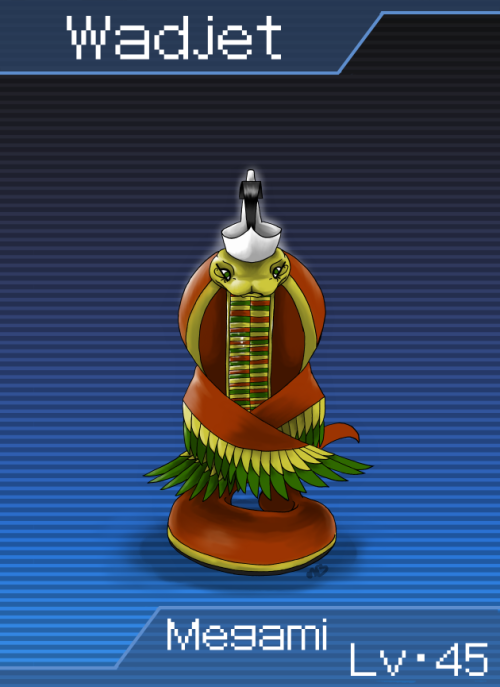
02 of 05 - Modern Compendium: Kishin Family Part 4 - Megami Wadjet
Although modern matriarchal religions tend to simply create the religious figures they need, many branches of these religions are not above adopting gods and goddesses from other belief systems. Wadjet is a good example of this. Originally a goddess of protection and motherhood from the Lower Kingdom of Egypt, Wadjet has been adopted by some practitioners of Neopaganism. Surprisingly, there’s fairly little alteration between her old home and the new one; she’s still seen as a guardian, particularly of expectant mothers, and she’s still seen as a winged snake.
Interestingly, in addition to being a goddess of motherhood, Wadjet was also the personification of the Eye of Horus. The Eye was an intensely important symbol to ancient Egyptians, symbolizing the protection of the gods and the wisdom of Horus himself. Modern Neopagans seem to have adopted this idea almost without alteration; whether this is out of respect or because Egyptian religion was in vogue when many goddess religions came to prominence will probably never be clear. It is, however, an interesting interaction between two societies separated by thousands of years, and a good reminder that no belief system is dead if someone – anyone – remembers it.
Wadjet sits fairly low in the Megami family; fact is, belief in her just isn’t that widespread. She is an exemplar of the Megami family, though. Wadjet sports high Magic, and comes loaded with powerful healing and defensive magic for her level. Personally, I see her as being one of those annoying enemies you tend to meet about midway through the game that heals the enemy team. Always target the healer first!
For more info on this and every other demon in the Modern Compendium take a look at the Data File, right over (here).
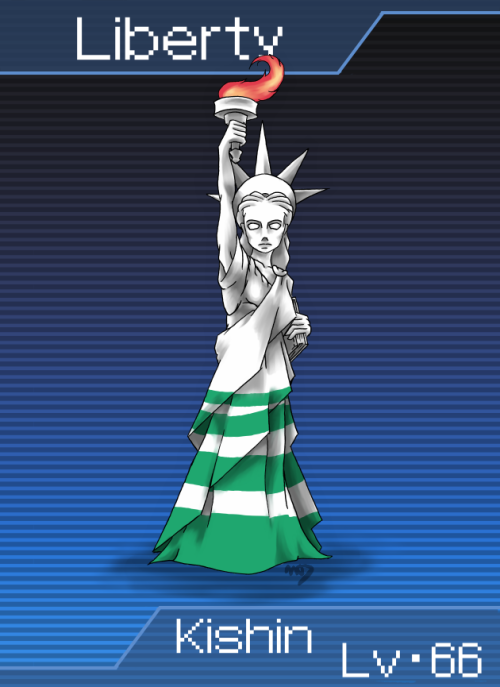
01 of 05 - Modern Compendium; Kishin Family, Part 4 - Kishin Liberty
First off, I have to apologize; this was supposed to go up on the 4th. I always underestimate how busy the holidays can become. But the rest of the month’ll be full of Mom and Apple Pie, so it’s not a total loss. ^^
Anyway, Liberty! I actually considered doing Uncle Sam, but it turns out that Lady Liberty actually has a long – and I mean long – history behind her. Way back in Roman times, they worshiped a figure called Libertas, a goddess seen as so powerful that she was often equated with Sol Invictus, one of the central gods of the late Roman Empire.
The Statue of Liberty was a gift from France, where Liberty had come to prominence during the French Revolution. Hell, for a time Notre Dame was actually re-christened as a sort of temple to the “Cult of Reason,” and who did they turn to for a replacement for the Virgin Mary? Liberty.
The figure of the statue itself is actually used as a national personification by both the United States and France, where she is sometimes called Marianne. For a while, Americans knew her as Columbia, too, but that practice mostly fell by the wayside as Uncle Sam came to popularity in the 1930s and 40s.
Liberty is an incredibly popular figure in modern society. She’s appeared on everything from money to postage stamps to little souvenir figurines. And if having your likeness in millions of homes isn’t worship, I don’t know what is. Liberty is incredibly powerful, but she’s actually the second highest level Kishin. And the one demon above her is… Special.
For more information on this and every other demon in the Modern Compendium, have a look at our mysterious Data File, right over (here).
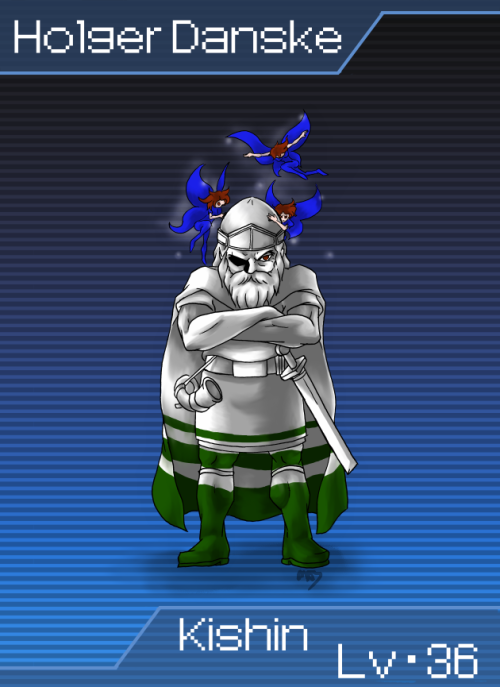
05 of 05 - Modern Compendium; Kishin Family, Part 3 - Kishin Holger Danske
A symbol of national pride and resilience, Holger Danske, also called Ogier the Dane, is about as pure a Kishin as you can find for the people of Denmark. He first entered the mythological lexicon of northern Europe in the 11th century, in the epic poem The Song of Roland. Holger appears as one of Charlemagne’s knights, leading a column of men against the enemy. Though he rarely stood out from other characters in the poems and stories he appeared in, Holger Danske quickly became a fan favorite of the Dutch people, leading him to appear in numerous stories up until the present day.
The most significant of these, at least for our purposes, is an opera called Holger Danske. The opera tells the story of yet another quarrel between Titania and Oberon, one so bad that Titania will only return if Oberon can find a human who exhibits all the qualities of loyalty and faithfulness that she says he lacks. Oberon happens upon Holger, who is on his way to the middle east to serve a penance for killing one of Charlemagne’s sons, and the two begin to work together. Anyway, long story short, Holger tricks a Sultan and defies burning at the stake to win the hand of his daughter in marriage.
Holger Danske was actually a fairly unpopular opera for its time, but the thematic elements of its music, which rejected German influence in Dutch culture, found a chord with the public during the Nazi occupation in 1941. Holger Danske became something of a rallying cry for the Dutch Resistance, to the point where one of the larger Resistance groups – about 350 veteran soldiers – actually called themselves the Holger Danske.
Anyway, Holger hangs around the middle of the Kishin family, but he’s really an exemplar of the group. He’s tough, offensive, and packs a very useful Physical resistance despite his low level. Definitely a solid choice for an early-mid game tank. ^^b
For more information on this and every other demon in the Modern Compendium, have a look at our Data File, right over (here).
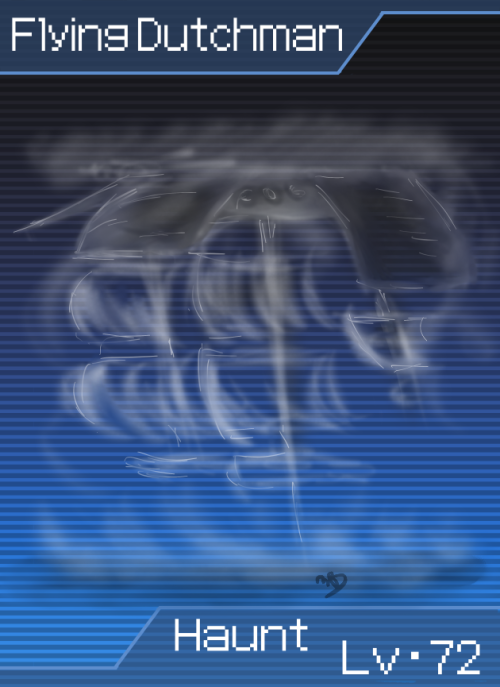
04 of 05 - Modern Compendium: Kishin Family, Part 3 - Haunt Flying Dutchman
One of the more unique ghost stories to be passed around in the last hundred years or so, the Flying Dutchman is one of the cornerstones of the traditional ghost ship story. Though it is fairly uncommon to come across someone who genuinely believes in the Dutchman these days, its mythology has been spread far and wide by sailors, and in modern times, by the series of Pirates of the Caribbean movies.
Tales of the Flying Dutchman may have begun circulating as early as the 17th century, but our earliest actual record of the ghost ship is from 1795, where George Barrington writes in his book, A Voyage to Botany Bay, about a Dutch ship that was lost off the Cape of Good Hope. Thereafter sailors would report a ghostly ship that would attempt to run them down, chasing them all the way to port before vanishing in a black cloud.
These stories were extremely popular for their time, but by the 20th century, people were eager to explain sightings of the Dutchman as drunken illusions on par with the manatees-turned-mermaids, or as a specific kind of mirage called a Fata Morgana, which creates a mirror image of a ship in the sky above the horizon.
Though not many people still believe in the existence of the Flying Dutchman, its mark on global culture is profound and unmistakable. This pedigree is more than enough to secure it a position at the top of the Haunt family.
For more information on and links to every demon in the Modern Compendium, have a look at our Data File, right over (here).
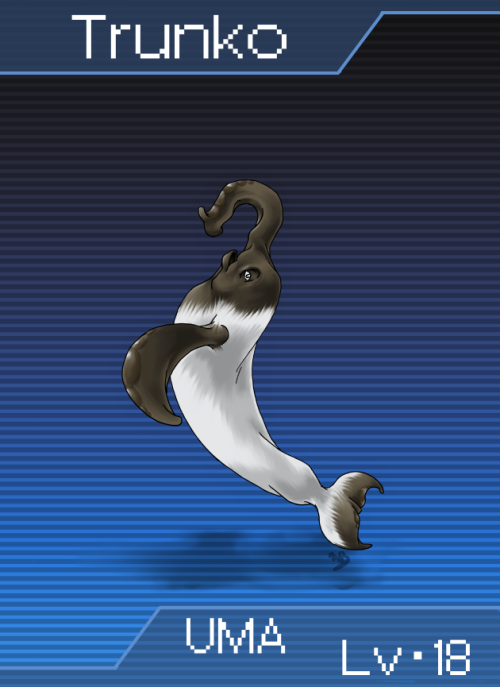
03 of 05 - Modern Compendium: Kishin Family, Part 3 - UMA Trunko
A Cryptid first sighted off the coast of South Africa in 1924, Trunko is an enduringly popular critter, despite very few modern sightings. Perhaps its that ugly-cute coat of fur or the sheer bizarre appeal of an underwater polar bear/elephant/whale hybrid, but either way, this creature is regularly near the top of the list of famous Cryptids.
First seen being attacked by a pair of Killer Whales who battered the animal for three whole hours, Trunko later washed up on the shores of Margate Beach, where it drew a crowd. Beach-goers measured it at 14 feet long, but for some reason, no one managed to get an actual sample of the beast. Heck, to this day there exists only four actual photos of the corpse.
Science, as with so many heavily disfigured Globsters that wash up on shores all over the Earth, is decidedly unimpressed with Trunko. The corpse could easily have been a partially decayed and dismembered whale, especially given the way that tough whale protein “shreds” as it decays, resembling white fur.
Trunko is one of the weaker UMAs, thanks largely to the easy explanations for its appearance and the fact that, despite its popularity, it just doesn’t get seen very much. Its also one of the last UMAs I’ll be designing - there’s only one more to go before this enormous family is done! :o
For more info on this and every other demon in the Modern Compendium, have a look at our Data File, right over (here).
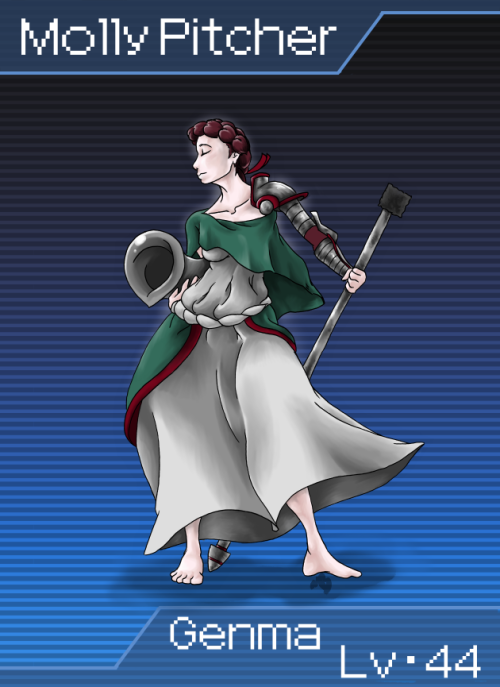
02 of 05 - Modern Compendium; Kishin Family, Part 3 - Genma Molly Pitcher
Say hello to our very first demon from the Genma family! In most Shin Megami Tensei games, the Genma family is home to demigods and half-human demons. The partially human aspect of this family is really fascinating, so I’ve given this part of the Modern Compendium over to figures from modern American folklore, which is unique in that it consists almost entirely of figures with superhuman powers, yet without an explicit connection to a god or gods.
Molly Pitcher is a particularly popular figure in American folklore. Supposedly, she was one of many women who followed their husbands off to war in the American Revolution. She worked on the battlefield tending the wounded and bringing water to the soldiers (hence Molly Pitcher), but when her husband fell in battle, she picked up his weapons and fought in his place.
Popular history says that Molly Pitcher was in fact an actual woman named Mary Ludwig Hays McCauley, who fought in the Battle of Monmouth in 1778. However, there are a huge number of stories that fit the general profile of Molly Pitcher tales, and the deeds of the woman in question have grown to superhuman proportions with retellings. This makes it likely that any stories you hear about Molly Pitcher are actually composites, built from the deeds of dozens of women, not just one.
Thanks to the enduring popularity of her story, Molly sits pretty snugly in the middle of the Genma family. Like most Genma, she’s primarily a physically offensive demon, but she does have some limited healing magic to throw around, too. All in all, she’s a very solid demon for the mid-game.
For more info on this and every other demon in the Modern Compendium, have a look at our extensive and ever-growing Data File, right over (here)!
(Incidentally I just wanted to mention that I briefly thought about designing Molly Pitcher to look like the Kool-Aid Man, as a reference to that goofy April Fool’s Day joke from a while back. But someone beat me to it. [link])
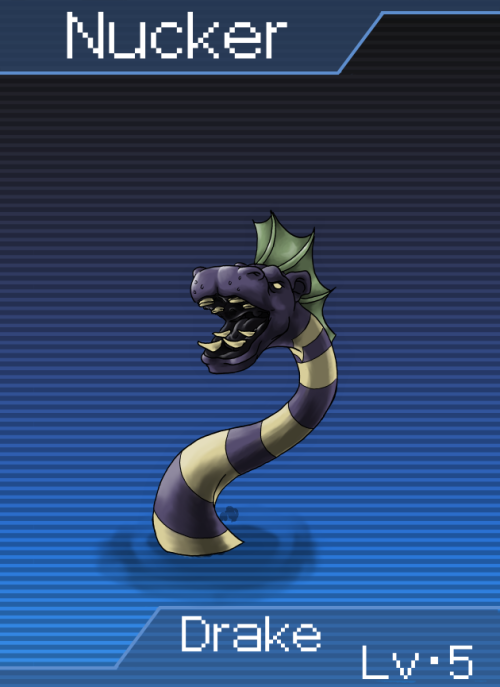
01 of 05 - Modern Compendium: Kishin Family, Part 3 - Drake Nucker
The Nucker is a myth on the verge of extinction. See, a long time ago, people thought every stream and lake had its own attendant serpent, and the early Anglo-Saxon people called these critters Nicor. They were said to hide at the bottom of pools of water, guarding fabulous treasure. The beast evolved over time to become a general water serpent, known in modern times as the Nucker.
These days, the Nucker is actually kind of obscure. This actually struck me as kind of weird at first; after all, it seems like every pond and lake in modern times has become home to weird cryptid snake critters, or at least sightings of them. But it occurs to me that most serpents that have surfaced in the last hundred years or so have been named beasts, with a strong connection to the area around them. They serve as a strong identifier of local culture, which isn’t something a more general jack-of-all-trades serpent can do. After all, what kind of sign would a sideshow make for a Nucker? “Come see OUR Nucker, it’s cooler than the Nucker they’ve got over in the next town!”?
Incidentally, a little further back in etymological history the word “nicor” was the Anglo-Saxon word for both “water spirit” and, for some reason, “hippopotamus.”
The Nucker is one of the lowest-leveled demons in the Modern Compendium, and one of the first demons you’re likely to ever encounter. It’s a bulky demon for its level, and actually offers some nice recovery magic for the early game, making it a decent critter to chat up for low level players. It’s also one of the few demons with an evolution, which we’ll be covering later.
For more info on this and every other demon in the Modern Compendium, have a look at our Data File, right over (here).
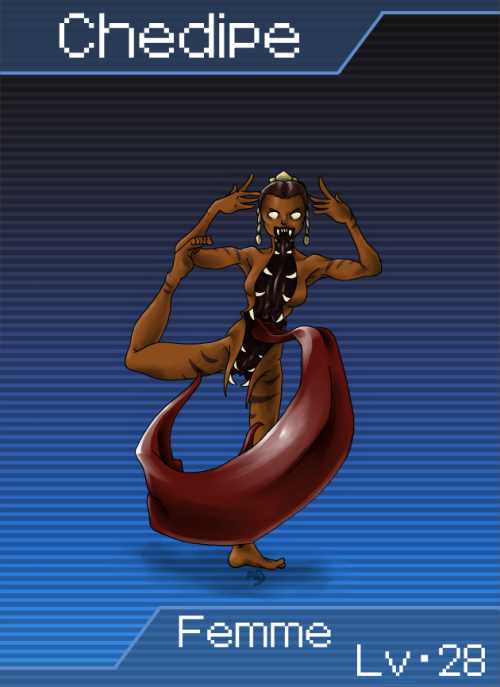
05 of 05 - Modern Compendium: Deity Family, Part 3 - Femme Chedipe
Throughout the Compendium, I’ve tried to include demons that speak not just to modern American sensibilities, but to various cultures all over the world. To that end, the Chedipe is a demon that has a lot to say about the recent history of India and the subcontinent.
The Chedipe is said to be a Vampire-like creature, a woman who seduces men and drains their blood. She sneaks into their rooms at night and drinks their lifeforce from their toes, returning night after night until her victim withers and dies. Legends say she can shapeshift into a tiger, leaping off into the night to escape pursuit, though one of her legs will always remain human. Chedipe are associated with devadasis, the dancing girls that once inhabited Hindu temples, but today these creatures are said to be born from any woman who dies an unnatural death, especially by childbirth.
The association the Chedipe has with devadasis is pretty significant to this demon’s history. See, back when the British colonized India, their utter lack of understanding of Indian culture caused a lot of friction. The British couldn’t tell the difference between devadasis who danced in the temples, and women who danced in the streets for money or for prostitution, so they lumped ‘em all together and outlawed the whole shebang. Between this and the destruction of the feudal lords that patronized temples, the devadasis were forced into the street, often into the very professions that the British had tried to eradicate by outlawing their art form.
I like to think that the Chedipe survived to the 21st century because it represents a memory of the injustices of colonial rule, as well as the lingering fear many women hold of being cast out of their homes with no real means of survival outside of prostitution.
The Chedipe is sometimes described as a witch or enchantress, whose shapeshifting abilities are evidence of some evil alliance. Between this and the demon’s aggressive, dangerous nature, the Chedipe fits neatly into the Femme family.
For more info on this and every other demon in the Modern Compendium, have a look at our Data File, right over (here).
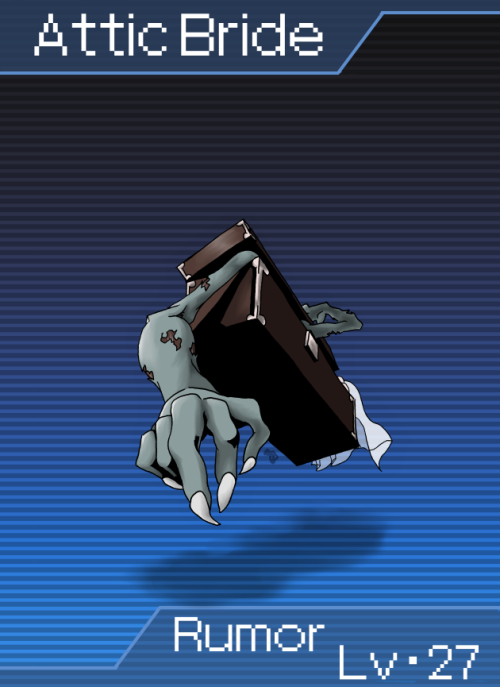
04 of 05 - Modern Compendium: Deity Family, Part 3 - Rumor Attic Bride
A popular and deceptively old urban legend, the story of the Bride in the Attic is one of those stories that gets told around campfires and on Halloween for chills, but not many people actually take it seriously.
The myth itself tells the story of a woman who, after many years of waiting and longing for a husband, fell in love and married the man of her dreams. After a fairy tale wedding, their friends and family treated them to a big house party with all the trimmings. Eventually someone suggested that they play some party games, and they started with Hide and Seek. The bride ran to the attic and hid in an old steamer trunk, and waited for someone to find her.
But no one ever did. The door to the attic had shut behind her, and the trunk had locked as it fell down on top of her. The wedding guests looked and looked, but it wasn’t until years and years later, when her widowed husband finally died, that anyone thought to look in the old trunk in the attic.
The story itself has a huge number of variations. Some versions have the husband as a sinister man who intended the bride to be locked in the attic, but he never gets his hands on her wealth because her vengeful spirit comes back to haunt him. Other versions have the husband himself finding the bride weeks or months later, as she begins to smell. Often a beating heart or spooky thumps on the ceiling are involved. But the most common alteration to the story is the city in which it happens; most people make sure the story takes place “just down the road” or “in a town just like this one” for maximum fireside spookies.
The Attic Bride fits easily into the Rumor family, but because it’s not a story that many people take very seriously, it’s not a particularly powerful demon. She is one of the few Rumors that is weak to Dark, though, so the Bride does have one unique thing to her credit.
For more info on this and every other demon in the Modern Compendium, have a look at our expanding Data File, right over (here.)
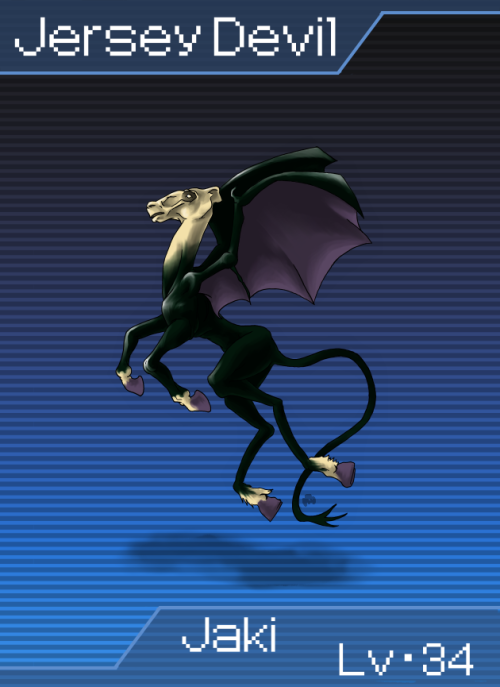
03 of 05 - Modern Compendium: Deity Family, Part 3 - Jaki Jersey Devil
One of the few demons from the official Demonic Compendium to make its way into this project, the Jersey Devil is a shoe-in for the Modern Compendium. Modern America has thoroughly embraced this demon, to the point where there is actually a hockey team called the Jersey Devils. It is deeply ingrained in popular culture, sitting amongst such figures as Bigfoot and Nessie in the collective consciousness.
The myths around the Jersey Devil have a few significant permutations, but the basic story goes like this; In the mid-18th century, the Leeds family lived in the back woods of New Jersey. Mother Leeds gave birth to twelve healthy children, but by the 13th child, she was fed up. As the 13th was born, she shouted, “This one shall belong to the Devil!” The child transformed into a hideous monster, killed Mother Leeds and the midwife, and flew up the chimney and out into the night.
Some variations of the story cast Mother Leeds as a witch who slept with the Devil, while others tell stories of clergymen who exorcised the Jersey Devil, sealing it for hundreds of years. My favorite versions of this story are the ones that include random famous people from history, like the version of the Bell Witch myth that have her tormenting Andrew Jackson. The Jersey Devil is said to have shocked the brother of Napoleon Bonaparte, amongst others, which is just awesome.
These days, the Jersey Devil has been largely recast as a Cryptid, a real, but undiscovered, animal, rather than the spawn of Satan. Which is just another example of people using pseudoscience to fill the mythological gaps left in modern life by scientific advancement. It may seem silly for modern man to believe in a horse-headed, bat-winged demon living in the pine barrens of the East Coast, but an undiscovered six-limbed animal with no precedent in the fossil record? No problem.
At any rate, the Jersey Devil has always occupied a rather moderate place in the Demonic Compendium, and he returns to pretty much the same place here. He fits perfectly in the Jaki family, which in the Modern Compendium represents man-eating monsters who are tied to a specific place.
For more info on this and every other demon in the Modern Compendium, have a look at our extensive and expanding Data File, right over (here)!
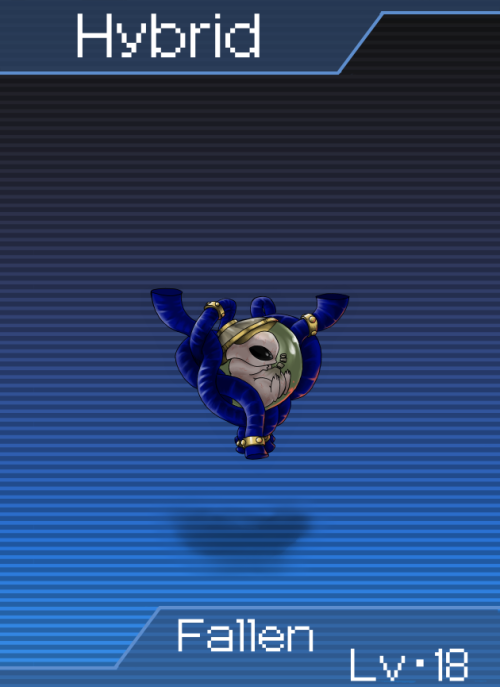
02 of 05 - Modern Compendium: Deity Family, Part 3 - Fallen Hybrid
Say hello to the first member of the Modern Compendium’s Fallen family! In Shin Megami Tensei games, the Fallen family is populated by angels that sided with Lucifer during his rebellion against and subsequent fall from Heaven. They are sort of the Chaos aligned equivalent of the Divine family, which is full of loyal, Law-based angels. In the Modern Compendium, the Divines are benevolent aliens from the mythology of UFO religions, and so the Fallen family shifts, too, becoming a family full of antagonistic aliens.
The stories around UFOs and aliens represent one of the richest veins of mythology in the modern mind, and one of the more popular tales people tell has to do with the Grey aliens. Often blamed for alien abductions, the Greys are said to perform elaborate and invasive procedures on the reproductive systems of the people they kidnap. These stories have led to theories that Greys are trying to create a race of Grey/Human hybrids, to infiltrate our culture and take over the world.
In fact, the actual purpose of this hybridization varies hugely depending on who is telling the story. Though many conspiracy theorists believe in the whole Greys-are-invading-our-genome-to-enslave-us idea, those who believe in more benevolent aliens tell stories of children with enhanced powers of empathy and kindness. This is best exemplified in this demon’s direct mirror in the Divine family - Indigo Children.
Anyway, I like to think the Hybrid would be roughly equivalent to Melchom or Orias; a low-level Fallen that serves as a common encounter in the early game. Although the Hybrid’s moveset kind of makes it closer to Gremlin, really.
For more info on this and every other demon in the Modern Compendium, have a look at our extensive and expanding Data File, right over (here).
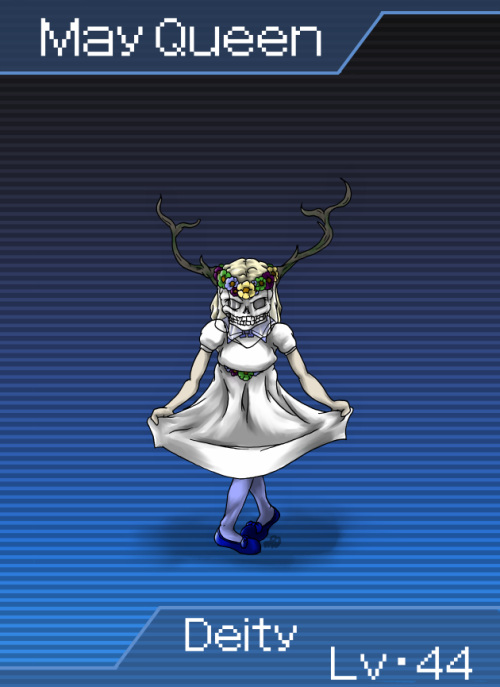
01 of 05 - Modern Compendium: Deity Family, Part 3 - Deity May Queen
The May Queen is a demon that shows the difference between what the basis of a myth actually is, and what people think it is. In modern times, the May Queen is a young woman elected to preside over May Day celebrations, to walk at the head of the parade and open the holiday dances. Historically, the May Queen is related to ancient tree worship, as this figure is closely connected with Maypoles, and the celebration of the return of spring. She wears a white dress to symbolize purity, and flowers in her hair to celebrate the renewal and rebirth of nature.
However, the May Queen is a myth whose historical fact has been largely overtaken by popular folklore. There is a popular and persistant urban legend that, somewhere in the murky depths of time, the May Queen was actually a sacrifice in waiting. Supposedly the people of English villages would select a young woman, give her all the best that they had to offer, and then, after May Day had passed, sacrifice her to some vicious pagan god. No doubt bloody stone altars and obsidian knives were involved.
However, and this is important to note, there is no evidence that I can find to actually back up the idea that this was ever done. As far as I can tell, someone somewhere just thought it sounded like a neat thing to tack on to the May Queen, and it stuck. Equally important is the fact that this gory and disturbing footnote to May Day is in fact very widely believed. No doubt the horror film The Wicker Man and its atrocious-bordering-on-comical 2006 remake are at least partially to blame, but whatever the cause, society at large has no trouble imagining a vicious start to this May Day tradition.
In any case, it is unfortunate for the May Queen that the version of any myth that matters for any practical purpose is the one that people actually believe in. And so the May Queen that gets into the Modern Compendium is the one with the disturbing backstory. The May Queen actually sits on the lower end of the Deity family, due in part to the dubious nature of belief in this version of her, but also because May Day celebrations aren’t hugely widespread outside of Europe and select parts of North America.
For more info on this and every other demon in the Modern Compendium, have a look at our Data File, right over (here).
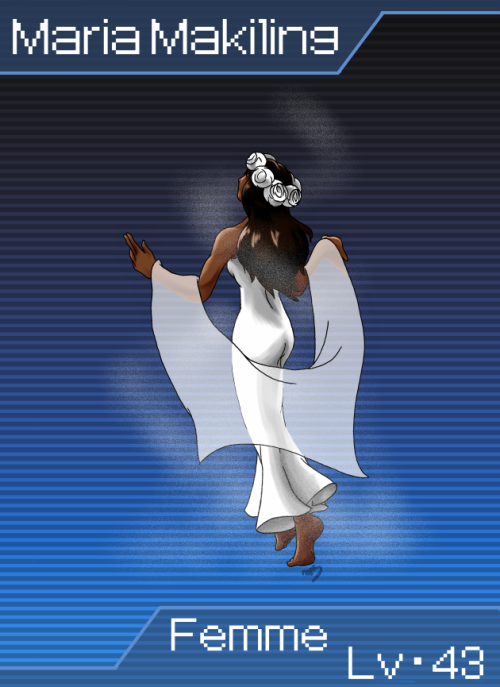
05 of 05 - Modern Compendium: Deity Family, Part 2 - Femme Maria Makiling
A major figure in the folk mythology that surrounds Mount Makiling in the central Philippenes, Maria Makiling is what is known as a Diwata, nature spirits roughly analogous to a nymph or fairy. Maria herself has roots that go back to the native cultures that inhabited the islands of the Philippenes before the European invasions, but as far as we can tell, she has always been seen as a protector of the mountain and surrounding areas.
What I find fascinating about Maria Makiling is how little the modern world has changed her. People that live around Mount Makiling still report seeing a dark haired, dark skinned woman in white wandering the wilderness, aiding those who respect and revere nature, and cursing those who despoil it. She’s even said to confuse those who don’t clean up after their campfires and picnics, turning the forest into an inescapable maze until they tidy up after themselves.
As an eternally young woman who is constantly pursued, but who only allows those she deems worthy to find her, Maria Makiling is eminently suited to the Femme family. Her kind nature does make her a bit of an unusual figure in the normally very offensively-focused Femme family; she’s more interested in healing spells and a few status effects than in actually dealing damage.
For more info on as well as links to every demon in the Modern Compendium, have a look at our extensive Data File, right over (here).
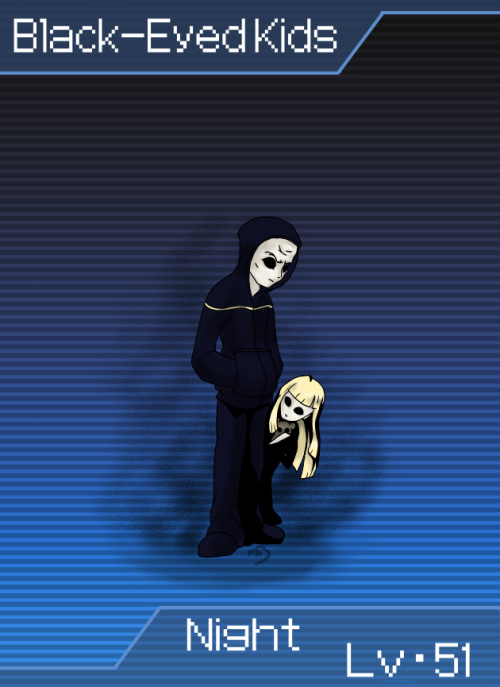
04 of 05 - Modern Compendium: Deity Family, Part 2 - Night Black-Eyed Kids
A redesign of one of our first demons from way back in 2012 (which can be seen [here]), Black-Eyed Kids is a myth that hasn’t actually moved very much in three years. It’s still fairly popular on the internet, and has actually gained some notariety in the minds of the general public. Stories of creepy children showing up in the middle of the night and demanding to be let in now occasionally show up on the same cable shows that showcase the spiritual tribulations of middle-aged housewives and paranormal investigators.
One of the ways Black-Eyed Kids have changed in the last three years is actually really bizarre; an explosion in the number of supposed explanations for this critter. When Black-Eyed Kids first appeared on the scene, there was little attention paid to the origins of these creepy munchkins. People were far more interested in simply relating stories of threatening teenagers than in where they came from. Today, however, we have “experts” theorizing that Black-Eyed Kids are everything from demons, to vampires, to government experiments gone horribly wrong. My personal favorite amongst these theories is the one that says Black-Eyed Kids are actually the end (or near-end) product of a decades-long human-alien hybridization project carried out by the Grey aliens. I await with baited breath the young adult paranormal romance novel about the teenage girl who falls in love with the mysterious escaped human-alien hybrid. ^^
Unexpectedly, Black-Eyed Kids would actually fit into a number of families. Their internet birthplace means they’d fit nicely into the memetastic Vile family, while their sinister alien background means they’d fit into several alien-based groups, including a couple we haven’t seen yet. But as critters of dubious cultural origin who are mostly associated with the dark, Black-Eyed Kids slot comfortably into the Night family.
For more info on this and every other demon in the Modern Compendium, have a look at our expanding and esoteric Data File, right over (here).
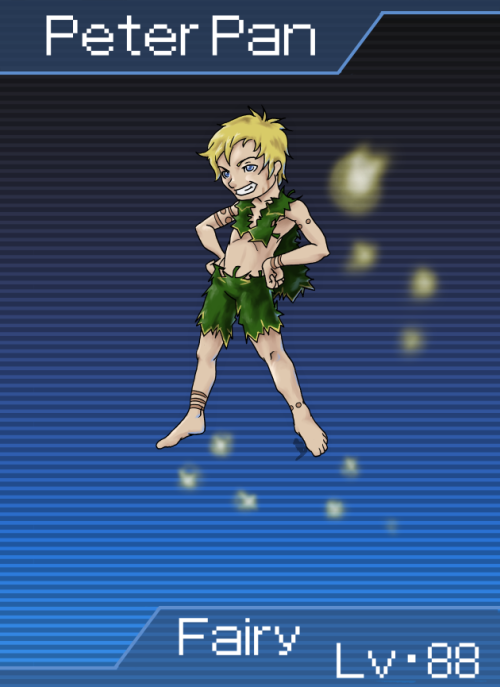
03 of 05 - Modern Compendium: Deity Family, Part 2 - Fairy Peter Pan
Though most people today know this fey youth through the popular Disney film, Peter Pan actually started out life as the brainchild of a Scottish novelist named J. M. Barrie. Barrie based Peter in large part on his older brother, who died at a very young age, but large parts of the character were also influenced by traditional fairy stories. In particular, Peter was supposed to have “left” his parents as a baby, only to come back later and find another child in his place, an element that strongly resembles the stories about Changelings, creatures of fae origin left in place of human children. And of course the idea of an eternally young human raised by fairies is a fairly common motif in fairy stories.
Like Jack Frost, Peter Pan has experienced a significant increase in popularity thanks to his inclusion in the canon of popular culture. These days, most people see Peter as a slightly mischievous, but usually heroic figure. However, his initial characterization was a bit more complex. Written as an exaggerated stereotype of a boastful and arrogant child, the original Peter Pan more or less personifies the arrogance of youth. One way this surfaces is in the way Peter retains his immortality, sacrificing his memories and experiences in order to remain young.
Peter was a pretty challenging demon to design, thanks to the great influence Disney has had in molding ideas about him. It was difficult to come up with a design that would include that source as an influence, but still look like it fit in a Shin Megami Tensei universe. In the end, I tried to go for a design that emphasized Peter’s feral arrogance, but still retained some whimsy and humanity.
Peter’s near ubiquity in the cultural lives of children means he’s a very robust figure in the Fairy family, coming in right at the top. He gets some very strong skills, but thanks to the Fairy family’s low power overall, he’s not overwhelming. I like to think Peter would be one of your first real end-game demons.
For more info on this and every other demon in the Modern Compendium, have a look at our Data File, right over (here)!